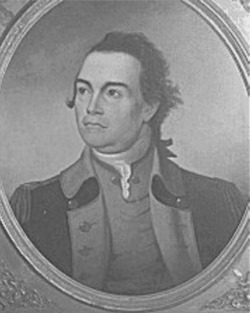John Sullivan
1740 - 1795

https://www.thenmusa.org/
I was a general, a statesman, and a man of contradictions.
I was born on February 17, 1740, the son of Irish immigrants from the O’Sullivan Beare Clan. Little is known about my early years, but I came up tough in New Hampshire and became a practicing attorney in the town of Durham. I made enemies quick, suing neighbors and foreclosing on debts. Some even petitioned the General Court to get relief from my demands. I fought back and won. The petition was dropped, and I sued the prosecutors for slander.
I married Lydia Remick Worster of Kittery, Maine, in 1760. We had six children together, though two died very young. My son George would go on to serve as a U.S. Representative. At one point, I was close friends with New Hampshire’s Royal Governor, John Wentworth. But as tensions with Britain rose, so did my ambition. I sided with the Patriots, ending our friendship for good.
I had once been appointed a major in the local militia by that same governor. In 1774, I was sent to the First Continental Congress and signed the Continental Association. A year later, I was a brigadier general in the Continental Army, fighting at the Siege of Boston. By early 1776, I was in Canada taking command of retreating Patriot forces after General John Thomas died of smallpox. That same year, I was promoted to major general and then captured after the British victory at the Battle of Long Island.
I was held prisoner for three months, released in December by exchange, and quickly returned to duty. I joined Washington in New Jersey and crossed the Delaware on Christmas night, leading my men to block the Assunpink Creek bridge and trap Hessian forces trying to escape Trenton. That victory helped change the course of the war.
But 1777 wasn’t kind to me. I clashed with Congress, was passed over for promotions, and took blame for our loss at the Battle of Brandywine. Still, I kept pushing forward.
In 1779, I led what became my most infamous campaign: the Sullivan Expedition. With orders from General Washington, I commanded a scorched-earth march into Iroquois territory, joined by General James Clinton. Our goal was to cripple British-allied forces in the region. We destroyed more than 40 villages, burned crops, and dismantled winter stores across the Finger Lakes. The only major battle came at Newtown, where 3,200 of our troops defeated a smaller force of Iroquois and Loyalists. After that, we returned to camp. The aftermath was brutal. Thousands of Iroquois civilians were left to suffer the winter with no food or shelter. Many died from starvation or exposure.
By October, I was in poor health and stepped away from military service. But I wasn’t done. I served in the Continental Congress, became attorney general of New Hampshire, was elected governor multiple times, and later became a federal judge under the new Constitution.
I died at home in Durham on January 23, 1795.
Some remember me as a bold general and dedicated public servant. Others look at the Sullivan Expedition and see something far darker. Historians have debated the intent behind that campaign for generations. But I stood where I believed I was needed, and I fought for the nation we were trying to build.
